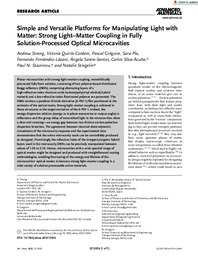Título :
Simple and Versatile Platforms for Manipulating Light with Matter: Strong Light–Matter Coupling in Fully
Solution-Processed Optical Microcavities |
Autor :
Strang, Andrew
Quirós-Cordero, Victoria
Grégoire, Pascal
Pla, Sara
Fernández-Lázaro, Fernando 
Sastre-Santos, Ángela 
Silva Acuña, Carlos
Stavrinou, Paul 
Stingelin, Natalie |
Editor :
Wiley |
Departamento:
Departamentos de la UMH::Farmacología, Pediatría y Química Orgánica |
Fecha de publicación:
2023-05-16 |
URI :
https://hdl.handle.net/11000/33852 |
Resumen :
Planar microcavities with strong light–matter coupling, monolithically processed fully from solution, consisting of two polymer-based distributed Bragg reflectors (DBRs) comprising alternating layers of a high-refractive-index titanium oxide hydrate/poly(vinyl alcohol) hybrid material and a low-refractive-index fluorinated polymer are presented. The DBRs enclose a perylene diimide derivative (b-PDI-1) film positioned at the antinode of the optical mode. Strong light–matter coupling is achieved in these structures at the target excitation of the b-PDI-1. Indeed, the energy-dispersion relation (energy vs in-plane wavevector or output angle) in reflectance and the group delay of transmitted light in the microcavities show a clear anti-crossing—an energy gap between two distinct exciton-polariton dispersion branches. The agreement between classical electrodynamic simulations of the microcavity response and the experimental data demonstrates that the entire microcavity stack can be controllably produced as designed. Promisingly, the refractive index of the inorganic/organic hybrid layers used in the microcavity DBRs can be precisely manipulated between values of 1.50 to 2.10. Hence, microcavities with a wide spectral range of optical modes might be designed and produced with straightforward coating methodologies, enabling fine-tuning of the energy and lifetime of the microcavities‘ optical modes to harness strong light–matter coupling in a wide variety of solution processable active materials.
|
Área de conocimiento :
CDU: Ciencias puras y naturales: Química |
Tipo de documento :
info:eu-repo/semantics/article |
Derechos de acceso:
info:eu-repo/semantics/openAccess
Attribution-NonCommercial-NoDerivatives 4.0 Internacional |
DOI :
https://doi.org/10.1002/adma.202212056 |
Publicado en:
Advanced Materials, Volume36, Issue20, May 16, 2024 |
Aparece en las colecciones:
Artículos - Farmacología, Pediatría y Química Orgánica
|

 La licencia se describe como: Atribución-NonComercial-NoDerivada 4.0 Internacional.
La licencia se describe como: Atribución-NonComercial-NoDerivada 4.0 Internacional.
.png)